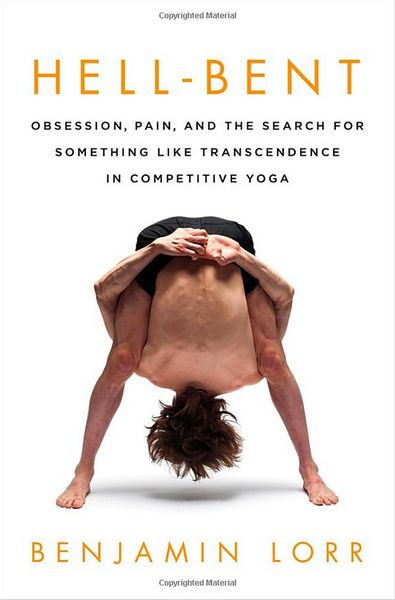Sharon Gannon, director of Jivamukti Yoga School, made a rare appearance at the Manhattan flagship this weekend. dropping in to teach two classes. I was fortunate enough to secure a spot the Saturday class.
I say fortunate, because although I was an invited guest (by Jivamukti's PR person), it was a battle to get into the studio. By the time I reached the front desk--at 4:40 for a 5pm class--the three young girls working check-in had no knowledge of me, my name appeared on no list. Nor did they care to know or go out of their way to accommodate me. I was flustered and aggravated. The girls'--in matching shirts-- sunny 20-year old charm quickly dissolved into an "I really don't care" attitude. "You can sign in on the waiting list" was as much help as I got. "Next!" (Fat chance I'd get in, either, since a friend of mine, waiting since 4:10, hadn't.) Why wouldn't Jivamukti want to be nice to the press?
This was my first experience at Jivamukti on Saturday.
The rest followed in a similar fashion.
I took matters into my own hands, found the studio manager, and got myself a place in class (though even he, too, had to insist that I belonged there.) Then, there was the question of physical space. One of the floor monitors thoughtfully put out a mat for me. But we were jam-packed, mat to mat, end to end, just like the old days.
And just like the old days, people around me seemed more oblivious than attentive. Coming into a stretch, the blond newbie in the row in front of me kicked me hard in the neck and shoulder. She then got up and looked at me as if astonished to see someone behind her. Her look seemed to say: why are YOU there? I asked myself the same question-- why am I here?--as I moved my mat three inches back, out of harm's way. She didn't seem to plan to move her mat (and why would she, really? kicking someone in yoga class is a normal way to defend your space, isn't it?). She offered no apology.
Sharon began the class with a slow, simple vinyasa, getting us into the mood to flow. (I should mention that Russell Simmons was practicing in the back row, to everyone's rapt attention.) Then we sat down and sang--I'm not kidding--a George Harrison song that expressed an idea Sharon wanted us to consider, "Any road will take you there." "Sometimes you're cool, sometimes you're lame." The class was about setting an intention and then setting sail. Where is "there" you might ask? Apparently, it's "nowhere, duh." A concept that required no further explanation. (As in that popular 70s expression, wherever you go, there you are?)
Harrison's song was something Cat Stevens might have sung on a groovy afternoon in the 1960s--but in fact Harrison wrote and recorded it in 2002. The lyrics were sloppy, the sentiment easy, and the arrangement wildly outdated. I sang along the first time, while Sharon brought her headset around and had students sing into the mike, because I didn't want to be caught not singing along. I feared punishment. So did the friend beside me.
The we did a free-style vinyasa practice and they played the dreadful song again. I used my yogic skills to block it out (and then got kicked in the head).
Sharon continued with the class, nicely sequenced, fairly basic, nothing too sweaty. Then suddenly came some advanced poses quite close to the warm-up poses. Most of the class were women in their 20s, whose bodies are sort of perpetually ready for the challenge, but the men and the older women probably needed more time to warm up in order to avoid injury.
More than halfway through, Sharon handed the headset to her co-teacher Jules, a skinny man, with sparse facial hair, who got us into a deep forward bend and then went into a long, rambling story about teaching yoga in prisons. Sharon leapt to the rescue saying, "Jules, is this going to be a long story? You're going to keep them there all that time? Inhale up!"
Jules seemed hesitant and insecure. In fairness, what could he do when Sharon (rightly) corrected him? Perhaps having the studio director in his class made him stumble. His teaching seemed rote, not inventive, not coming from the heart, or from lived experience, but coming from a book or a set of directions. He gave instructions too slowly or too fast, and his jokes missed their mark.
He got us into wheel and embarked on yet another long story, from which Sharon again rescued us. Then he lashed out at her, "So I've got an embarrassing story about Sharon...." She objected--Hey!--and he admitted it was he who was embarrassed. But the whole situation was juvenile. It was highly unprofessional, and dare I say it, irresponsible. The guy seemed to have the most basic yoga training, and no understanding of the deeper reasons for practicing yoga--even as he was instructing us in these meanings.
To her credit, Sharon managed the situation well, but who was it who trained this poor, lost soul? I can't help feeling that the chaos, unfriendliness, and gracelessness of the studio is trickledown: directors instruct staff by their example as much as by their edicts. I get a sense of how the directors behave when they're not on stage.
Finally, we safely reached the end of the class. My nerves were fraught from the discombobulated instructions, poses, music, commentary, the closeness and obliviousness of other students, and the drab colors on the studio walls. What happened to the Jivamukti that was fun and exciting, if a little kooky? What I witnessed on Saturday was a relic--an organization trying to preserve a time gone by. Not Jivamukti's glory days, but the days of hippies, when alternative (and shallow, if I may say so) spiritualities justified themselves by their very existence, and were accompanied by a feeling of superiority, of not being "caught" in someone else's misconceptions, or even lies. Surely we (yogis included) are beyond that?
It was then especially irritating to have Jules read a bad--and rhyming, I might add--poem written by Gannon throughout our 5 minute meditation practice. At the end of a brief savasana, the lights came on abruptly and the music came back--George Harrison once again, ladies and gentlemen! Another sing-a-long with another chance to be broadcast throughout the studio.
This time, I gave my chant sheet to my friend beside me. I declined to sing along. I wondered where the dignity was in this. Where was the yoga? Was it fun for anyone? Or was I alone in feeling alienated, uncomfortable, and vaguely like I was trying out for a club I had no interest in joining?
There's almost never a yoga class that I can't get something from, at least the basic feeling of being more open and receptive. But I left Jivamukti feeling frayed and distressed. It was like being in Whole Foods for an hour at peak time, trying over and over again to pay for groceries, waiting on line, being jostled, trying to be patient. That's okay for Whole Foods--you know what you're getting into--but it's not okay for yoga, any yoga experience. Rather than feeling closer to the divine--in me or in anything else--I felt like I needed to start my day again. Which is too bad since I'd been having a good day up till then. The jangled feeling lasted all night.
Sharon or no Sharon, Jivamukti has grown into a force beyond its directors. It is unfocused, chaotic, and, sad to say, unhelpful. I was surprised that Sharon's presence didn't even things out at the center at all. Let's hope, in spite of this, that this mega-influential studio is still introducing impressionable youngster to the joys of yoga--in spite of what I experienced.
























